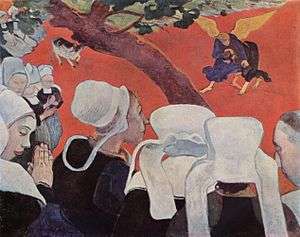Leeds Arts Club
The Leeds Arts Club was founded in 1903 by the Leeds school teacher Alfred Orage and Yorkshire textile manufacture Holbrook Jackson, and was probably one of the most advanced centres for modernist thinking in Britain in the pre-First World War period.
History
The Leeds Arts Club, founded by Leeds school teacher Alfred Orage and Yorkshire textile manufacture Holbrook Jackson, was an iconoclastic organisation that mixed radical socialist and anarchist politics with the philosophy of Friedrich Nietzsche, Suffragette Feminism, the spiritualism of the Theosophical Society and modernist art and poetry into a heady mixture. It had close associations with the Independent Labour Party, the co-operative movement and the early Fabian Society. At its weekly meetings it would often discuss the connections between art, spiritualism, philosophy and politics.[1]
In 1907 Orage and Jackson left Leeds and moved to London to edit the hugely influential cultural and political journal The New Age. Following their departure the Arts Club came under the sway of Frank Rutter, the founder of the Allied Artists Association and newly appointed Director of Leeds City Art Gallery, and Michael Sadler, the new Vice-Chancellor of the University of Leeds. Under their leadership the Arts Club maintained its interest in the relationship between radical politics, spiritualism and art, but this was expanded to encompass early psychoanalysis and, most significantly, abstract art.
Rutter initially had plans to create a modern art collection at the Leeds City Art Gallery, but had been frustrated in this aim by "boorish" local councillors.[2] He co-founded the Leeds Art Collections Fund with Sadler, to help acquisitions and shows, among one in June 1913 of Post-Impressionism held at the Arts Club, which was reactivated by the new activity. The discussions there about contemporary art, and the presence of Rutter, had a significant influence on the thinking of Herbert Read (1893–1968), who turned 20 in December 1913.[3]

Using his personal links with Wassily Kandinsky in Munich, Sadler built up a remarkable collection of expressionist and abstract expressionist art at a time when such art was either unknown or dismissed in London, even by well-known promoters of modernism such as Roger Fry. Most notable in his collection was Kandinsky's abstract painting Fragment for Composition VII, of 1912,[4] which was in Leeds and on display at the Leeds Arts Club in 1913. He also owned Paul Gauguin's celebrated work "The Vision After the Sermon". According to Patrick Heron, Kandinsky even visited the Arts Club in Leeds before the First World War.[5]
Leeds Civic Trust commemorated the Leeds Arts Club by a blue plaque on number 8 Blenheim Terrace where it met 1908-1923, opposite the University of Leeds. The plaque was unveiled on 15 May 2012, by Ingrid Roscoe, Lord Lieutenant of West Yorkshire, and a speech was made by Tom Steele, author of Alfred Orage and The Leeds Arts Club. The plaque had been suggested by Ben Read, art historian and son of Herbert Read. The inscription is:
THE LEEDS ART CLUB A highly influential forum for the avant-garde in politics, philosophy, art and literature met here from 1908. Ground-breaking exhibitions included the 1913 Post-Impressionist show and Cubist and Futurist Art in 1914. Famous speakers included G.B. Shaw and W.B. Yeats. 1903-1923[6][7]
Influence
In many respects the Leeds Arts Club can be seen as the closest England came to a genuine expressionist art movement, and this was accentuated not only by its interests, which mirror those seen in German expressionist art groups of the time, but in the Club's direct links to Kandinsky in Germany. It also produced its own expressionist artists, including Jacob Kramer and the little-known, but remarkable, painter Bruce Turner.
It also was the seed ground from which the eminent art critic and theorist Herbert Read emerged, and Henry Moore has been linked to it. If one takes Orage and Jackson's New Age as England's equivalent to the German expressionist journal Der Sturm, then it seems reasonable to view the Leeds Arts Club as the centre of English Expressionism.[8]
Notes and references
- ↑ Tom Steele, Alfred Orage and the Leeds Arts Club 1893-1923 (Mitcham, Orage Press, 2009) 65f and passim
- ↑ Tom Steele, Alfred Orage and the Leeds Arts Club 1893-1923 (Mitcham, Orage Press, 2009) 227
- ↑ Tom Steele, Alfred Orage and the Leeds Arts Club 1893-1923 (Mitcham, Orage Press, 2009) 218f
- ↑ Michael Saler, The Avant-Garde in Interwar England (New York: Oxford University Press, 1999) 52
- ↑ see Heron interview in B. Read and D. Thistlewood, Herbert Read: A British Vision of World Art, London 1993
- ↑ "Director's Blog May 2012 - What's New to the Trust". Leeds Civic Trust. Retrieved 3 June 2012.
- ↑ Crossen, John (June 2012). "Pioneering arts institution honoured: blue plaque for Leeds Arts Club". Leeds Civic Trust Newsletter: 1–2.
- ↑ See Michael Paraskos, English Expressionism (Leeds: University of Leeds, unpublished Phd, 1997) passim

